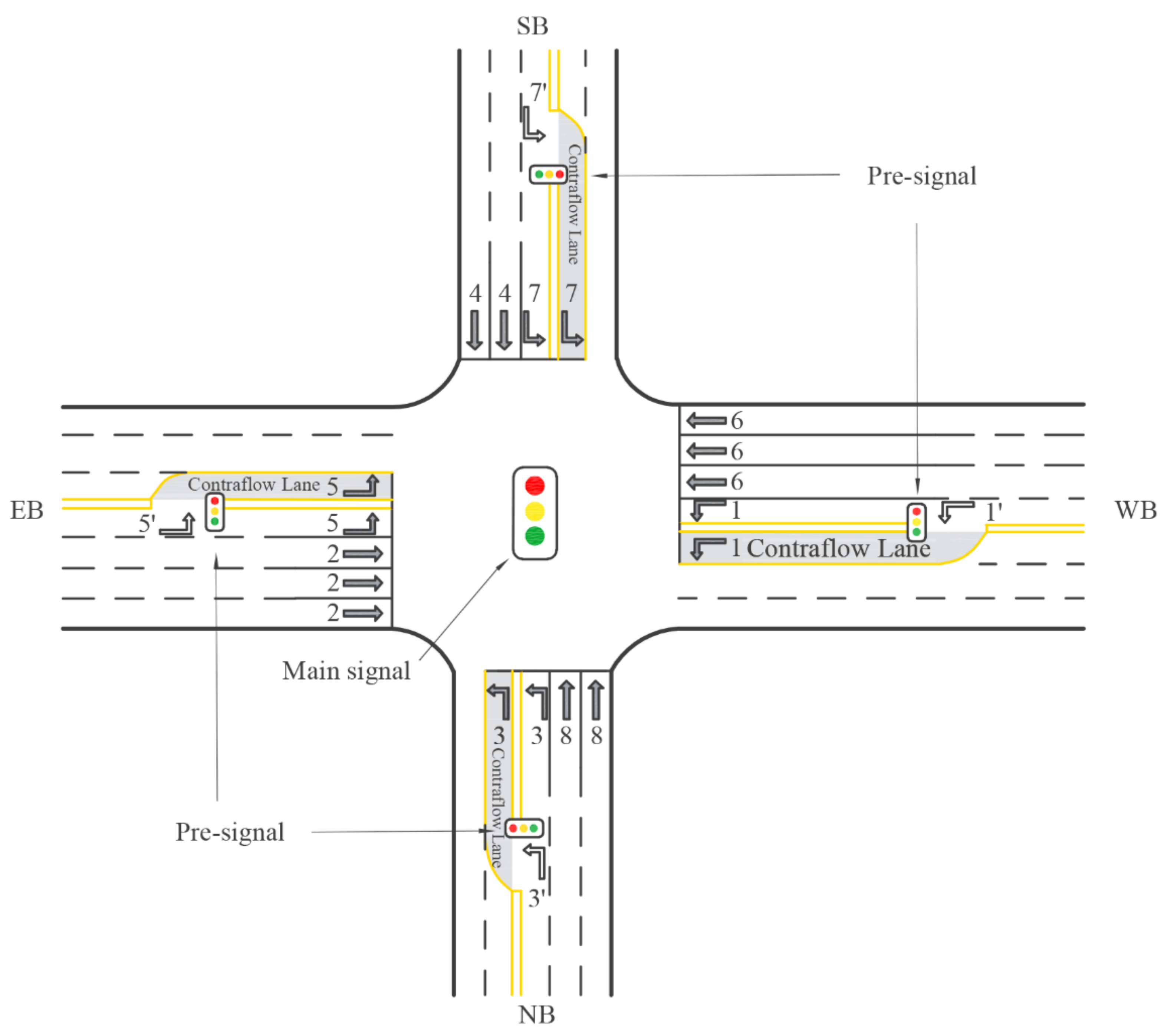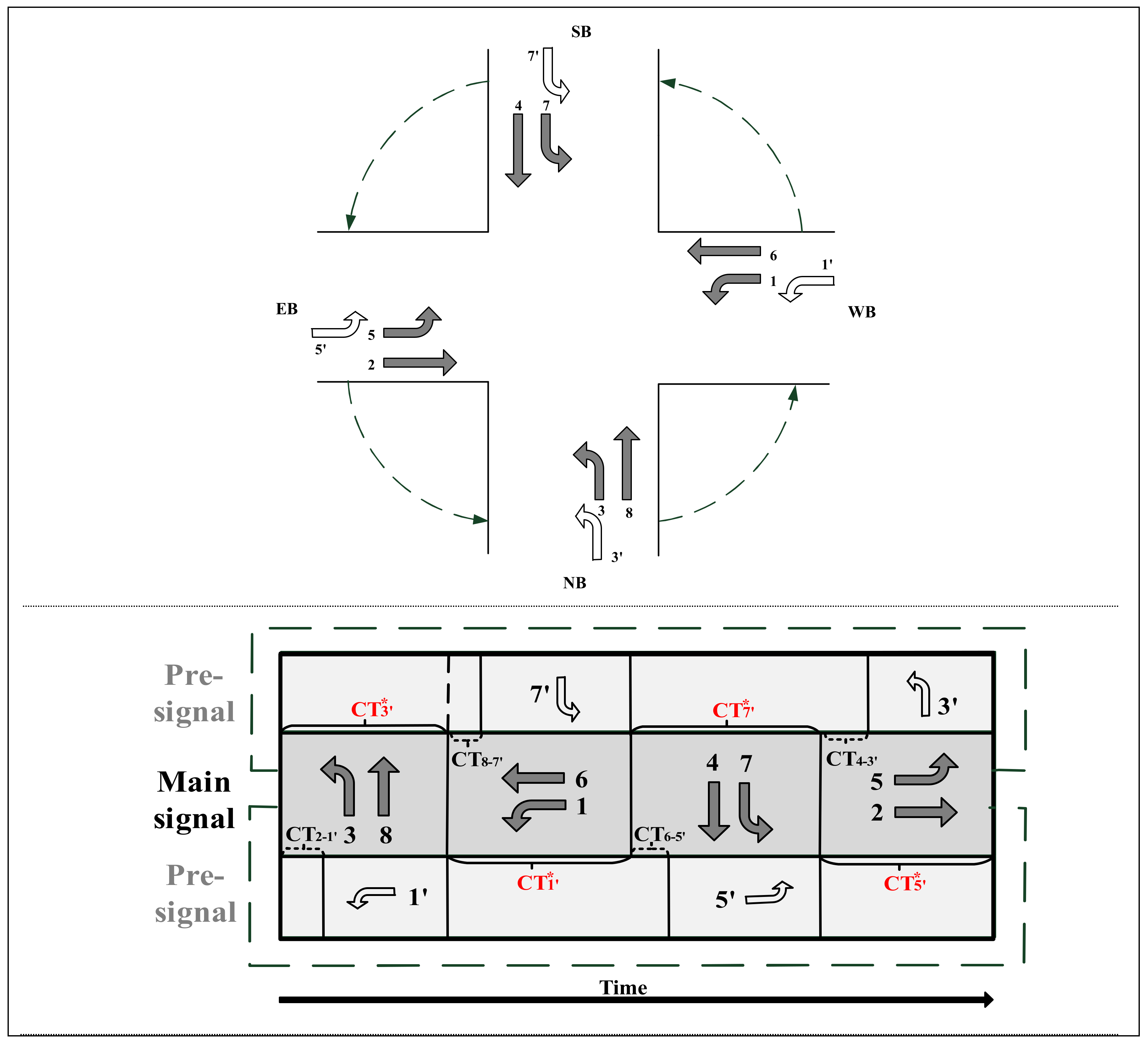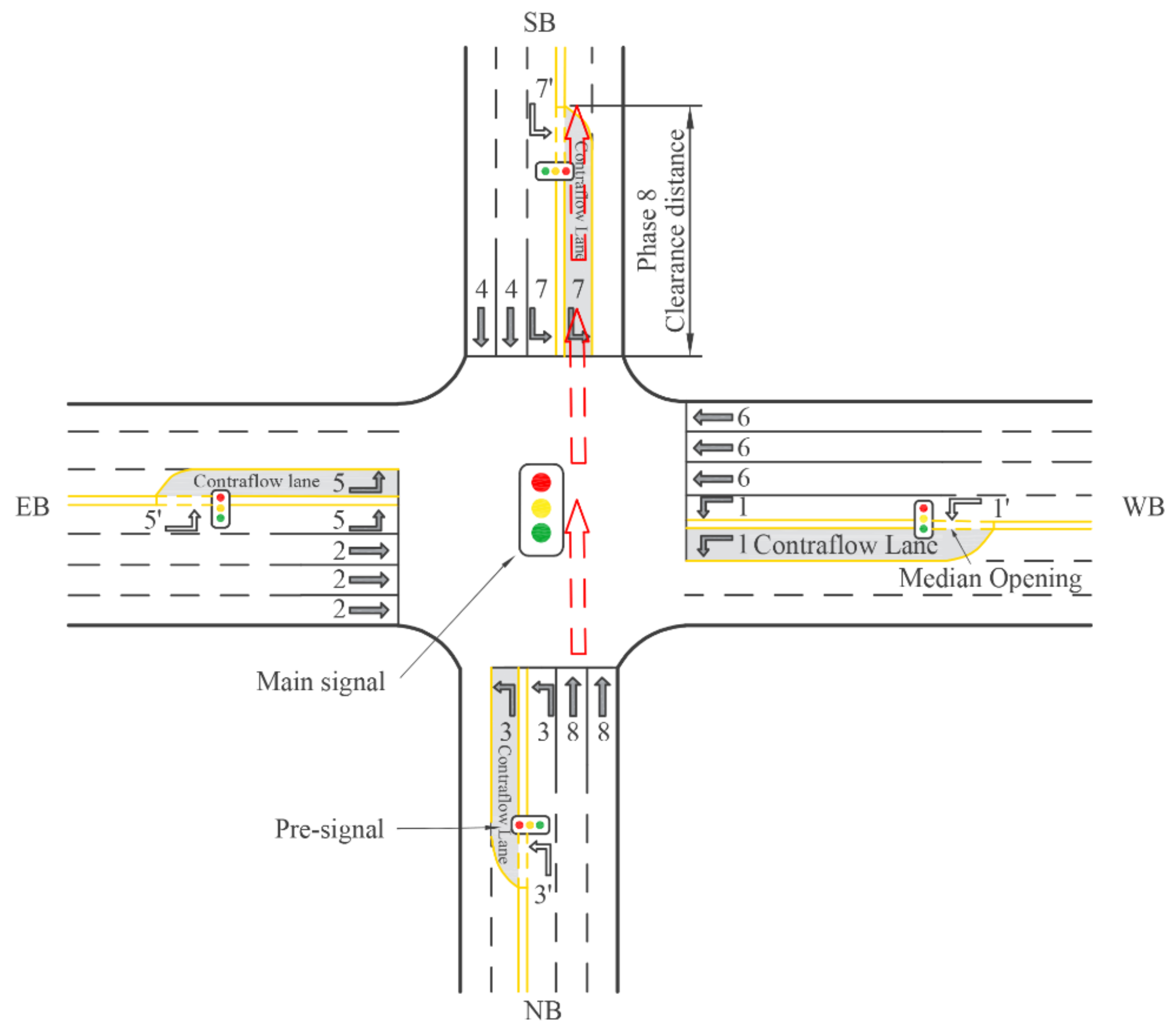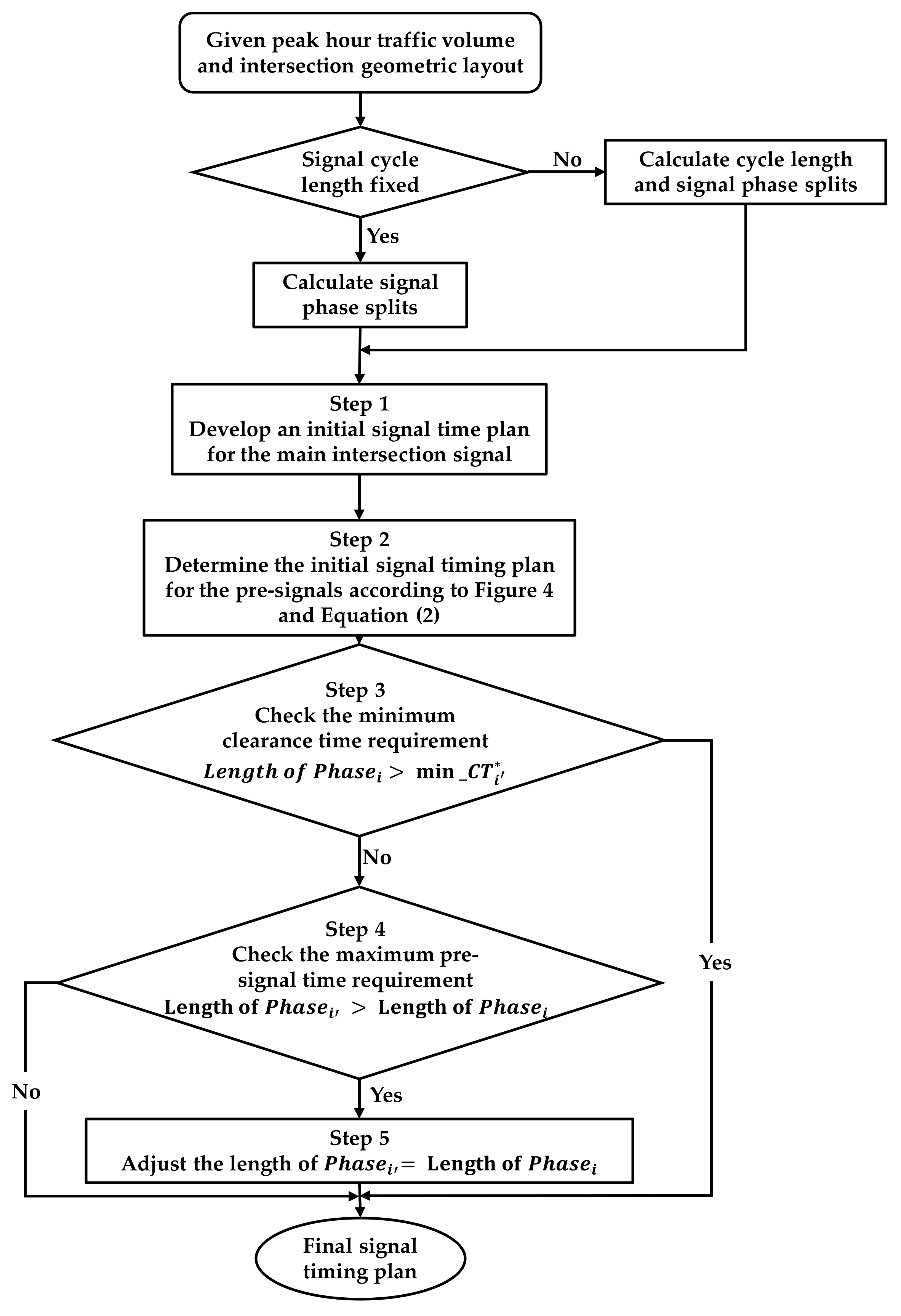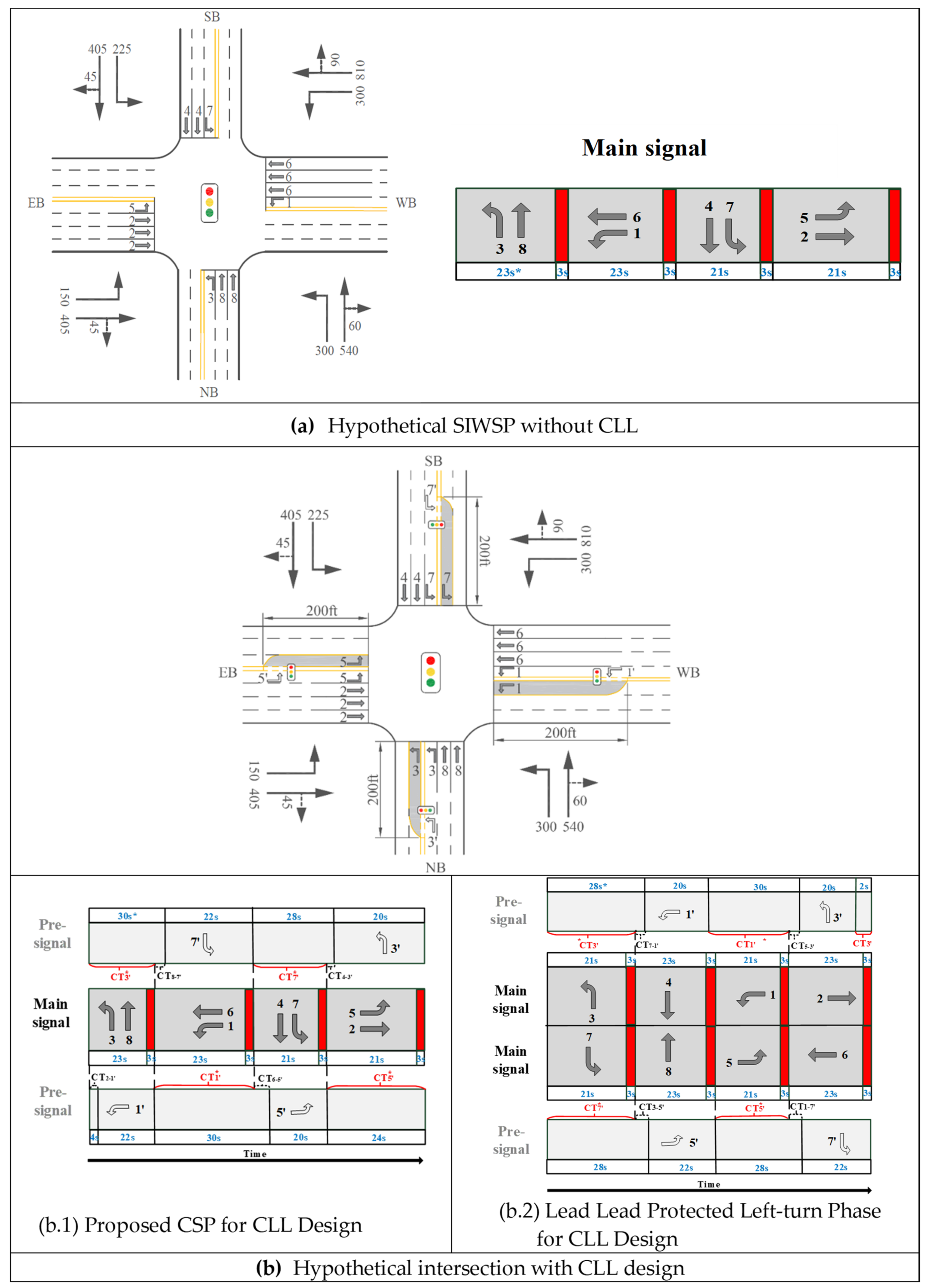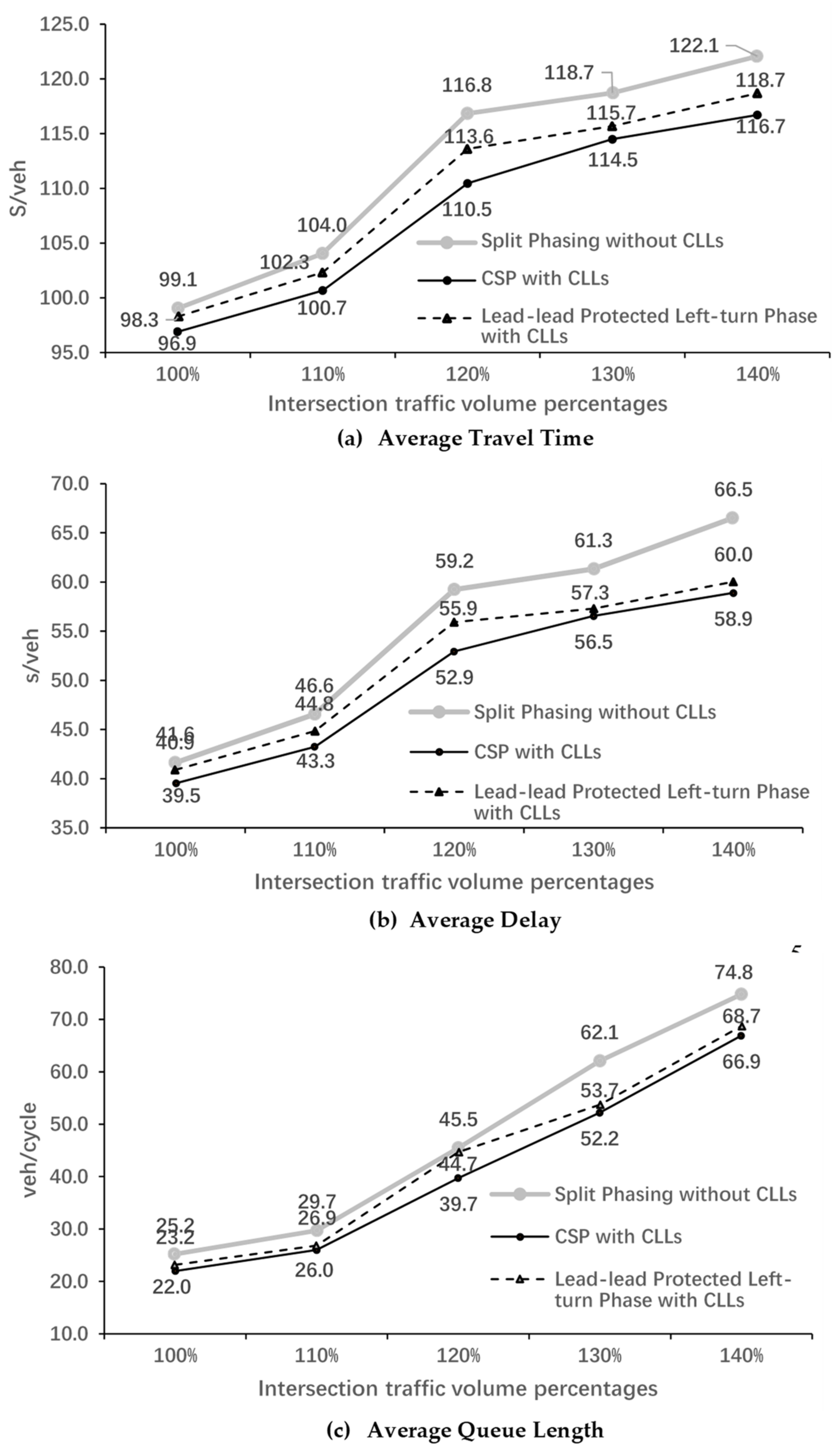1. Introduction
Traffic congestion is a critical issue for the sustainability of transportation development. It can cause traffic delays, reduced economic efficiency, and safety and air pollution problems. As traffic congestion increases, the need to maximize the utilization of existing lane configurations, and therefore improving the sustainability of the transportation system, is of great importance. At some intersections, excessive left-turn queue lengths may cause the queue to spill out of the left-turn bay and block the through lanes, which adversely affects the operation and safety of the entire intersection. An innovative intersection design, Contraflow Left-Turn Lane (CLL), is designed for solving the problem where the capacity of the existing regular left-turn lanes is insufficient for the increasing left-turn demand at a signalized intersection. The basic idea of this design is to dynamically use a portion of the opposing through lanes as additional left-turn lanes [
1] Wu et al., 2016.
Figure 1 shows the design concept of the CLL and
Figure 2 shows the signal timing plan used for such a design. Generally, the CLL is designed for use at signalized intersections with lead-lead protected left-turn phases. As illustrated in
Figure 1 and
Figure 2, a pre-signal and a median opening are set upstream of the CLL to allow the left-turn vehicles to enter the CLL during the signal phases for the crossing-through movements. The entered left-turn vehicles will wait at the CLL until the left-turn signal at the main intersection turns green. Then, they move together with other left-turn vehicles on the adjacent regular left-turn lane(s) during the leading left-turn phase. Note that the pre-signals will turn red before the left-turn signal at the main intersection turns red, and enough clearance time (CT) will be provided to ensure that all the left-turn vehicles on the CLLs can be cleared before the left-turn phase ends. In this way, the conflicts between the left-turn vehicles using CLLs and the opposing through vehicles can be avoided. As shown in
Figure 1, the shaded lanes are the CLLs, which can be used by both left turn and opposing through vehicles. With the CLL design, more existing lanes (i.e., opposing through lanes) can be used for moving left-turn vehicles. Thus, the capacity and operational efficiency of the intersections can be improved. In addition, this new design can be easily implemented without modifying the intersection in a way that requires major roadway construction. Therefore, it could be a low-cost solution for mitigating the traffic congestion at the signalized intersections, especially for the intersections with high left-turn demand [
2] CLL design was first proposed by a traffic manager in Handan, China, and was first implemented in that city in 2014. After that, due to its effectiveness in reducing intersection congestion, it has been widely implemented in over 50 intersections in 21 different cities in China since 2018 [
3].
Split phasing represents an assignment of the right-of-way to all movements of a particular approach, followed by all of the movements of the opposing approach [
4].
Figure 3 presents a split phasing signal timing plan. According to a FHWA study [
5], at the intersections where the left-turn lane volumes on two opposing approaches are approximately equal to the through traffic lane volumes and the total approach volumes are significantly different on the two approaches, split phasing may prove to be more efficient than conventional phasing. In addition, split phasing is necessary under certain intersection geometry conditions, such as when the opposing left-turn paths overlap because of intersection geometry layout [
4]. Thus, split phasing, as one important left-turn phase option, has its own advantages under certain intersection traffic and geometric conditions. However, the CLL design cannot be directly used at the intersections with split phasing. This is because one of the requirements for implementing CLL design is that the intersection should use leading protected left-turn phases on both streets [
3]. The CLL design cannot work with the lagging left-turn phase because, for the lagging left-turn approach, left-turn vehicles cannot be allowed to enter the CLLs during the signal phase that is right before the left-turn phase since this phase is for moving the opposing through vehicles that also need to use CLLs. However, in split phasing, the left-turn phase in one direction has to be the lagging phase. Therefore, CLL design cannot be directly used at the intersections with split phasing. To solve this problem, in this study an innovative signal timing strategy, which is referred to as Counterclockwise Split Phasing (CSP) signal timing, is proposed for the implementation of CLL at the signalized intersections with split phasing (SIWSP). The proposed signal timing strategy can combine the advantages of the split phasing and the CLL design to achieve more operational and safety benefits at the intersections where split phasing is recommended or required.
In this paper, previous studies related to the CLL intersections are reviewed and discussed first, followed by an introduction of the concept design of the proposed signal timing strategy. Then, a traffic simulation-based case study is conducted to demonstrate the application of the new signal timing strategy to a hypothetical CLL intersection, and its mobility benefits under various traffic conditions are assessed based on the simulation results. Finally, conclusions and recommendations are provided.
2. Literature Review
CLLs are also called exit lanes for left turns (EFL) or contraflow left-turn pocket lanes (CLPL), which belong to the category of dynamic or reversible lane design. Applying the CLLs at intersections is a relatively new design idea. Although it has been implemented in over 50 intersections in China, they are not currently implemented in North America. In recent years, several studies have been conducted in investigating the design, operational, and safety performance of the CLLs.
In Zhao et al. [
6], CLL was introduced as a left-turn congestion mitigation strategy for signalized intersections. In this study, an optimization problem for CLL control was formulated as a mixed-integer nonlinear program. The objective of this optimization problem is to maximize the reserve capacity of CLL. Twenty-four constraints were set to find the optimum solutions about geometric layout, main signal timing, and pre-signal timing for the CLL intersection design. The results show that the proposed CLL intersection increases the capacity of an intersection and reduces average intersection vehicle delay and queue length compared with the conventional intersection design.
Su et al. [
2] proposed an experimental design for evaluating signal timing and geometric design elements of CLL intersections. In this study, case studies were used to illustrate how the design concepts are applied and to examine the key design elements in the CLL, including pocket lengths, access control, and green signal times. In a case study, the operational advantages of intersections with CLL design under different traffic demand levels were evaluated. The results indicated that the CLL treatment can reduce the intersection delay by about 22% at intersections with high left-turn demand.
Wu et al. [
1] developed analytical models for estimating the capacity and delay of intersections associated with the CLL design. In addition, a procedure was developed to optimize the location of upstream median openings based on the developed capacity model. The results indicate that the CLL design can improve the intersection capacity and reduce traffic delay compared with the conventional left-turn lane design. It is also pointed out that one of the major concerns of the CLL design is the potential conflicts between the vehicles trapped in the CLL and opposing through vehicles.
Zhao et.al. [
3] developed a probabilistic model to estimate intersection capacity with CLLs. The impacts of the cycle length, left-turn demand, and lane selection preference on the capacity estimation of CLL intersection were also investigated. The results of this study indicate that the CLL treatment can increase a signalized intersection’s throughput by up to 25% and decrease the intersection’s delay by 35% on average.
Zhao et al. [
7] developed a saturation flow rate adjustment model that can be used for estimating the saturation flow rate at both the main intersection and the median openings for CLLs based on field-collected data at ten signalized intersections. In the development of this model, five influencing factors, namely the median opening blockage, demand starvation, multilane interference, conflict with opposing vehicles, and lane changing, were considered. The results of this model can be used for improving and optimizing the signal timing and geometric design of the CLL design.
Liu et al. [
8] proposed a shockwave-based model for estimating the maximum left-turn queue length of CLL at signalized intersections. In this study, a binary logit model was employed as an estimate of the unique queuing behavior at the pre-signals. To develop such a model, field studies were conducted at five signalized CLL intersections in Handan, China. Based on the field observations, it was found that although the chance of vehicles being accidentally trapped on the CLL is very small, the potential collision risks cannot be ignored.
Most recently, Wu et al. [
9] proposed a semi-actuated signal control strategy to improve the operations of the CLL design at signalized intersections. It proposed a procedure for optimizing the CLL length by maximizing the discharge rate of the left-turning vehicles and the utilization rate of the CLL. In this study, the interactive relationship between CLL length and traffic signal timing was considered by using simultaneous equations, and a shock wave-based model was used for estimating the left-turn queue backup length. Wu et al. [
10] also analyzed the operational performance of the CLL design by considering the influence of the upstream signalized intersection. It was found that both the intersection traffic arrival pattern and the lengths of the CLLs have significant impacts on the operational performance of the CLL intersection. In this study, an empirical optimization method was proposed for deriving the optimal length of CLLs and the signal offset between adjacent intersections to minimize the intersection control delay.
When implementing innovative intersection designs such as CLLs, driver acceptance is an important issue. Although this issue has not been explicitly discussed in the existing literature, some studies have investigated the driver’s behavior associated with the use of CLLs. Zhao et al. [
11] investigated driver behavior when approaching CLLs by employing a series of driving simulator experiments. In this study, the effects of different sign and pavement marking designs for CLLs were examined. The results of this study indicate that drivers show a certain amount of confusion and hesitation when encountering a CLL for the first time. However, this problem could be mitigated by public outreach, driver education, or the improvement of traffic signages. To overcome the limitation of the simulator-based study, Zhao et al. [
12] studied the driver’s behavior at seven real-world intersections with CLLs. Results indicated that the risks of using CLL intersections mainly lie in red-light violations at the pre-signal, wrong-way violation, and vehicles trapped in the mixed-usage area. In this study, countermeasures for preventing these risks were also identified.
Furthermore, to safely and effectively implement the CLL design, driving behavior characteristics related to left turns also need to be considered. For example, Frazier et al. [
13] found that drivers do not always select the leftmost lane (Lane 1) as their destination lane when turning left, which brings another risk in the use of CLL. This is because if two left-turn vehicles (one on the CLL and one on the adjacent regular left-turn lane) that are turning abreast choose the same destination lane, a sideswipe crash could occur.
From the literature mentioned above, it can be seen that most of the previous studies have indicated that the use of CLLs can improve the operational performance of the intersections. However, these existing studies are all based on the assumption that the signal timing phase at the main signal is the lead-lead protected left-turn phase. As we mentioned before, the CLL design cannot be directly implemented at signalized intersections with split phasing. Thus, for the intersections where the split phasing is recommended or required, the benefits of using CLL design cannot be achieved. This research aims to find a solution to this problem.
6. Conclusions
In this study, an innovative CSP signal timing strategy was proposed for implementing CLLs at the SIWSP. A four-step signal timing design procedure was developed. A traffic simulation-based case study was conducted to demonstrate the application of the proposed CSP signal timing strategy at a hypothetical SIWSP intersection. In addition, the operational benefits of using the proposed CSP signal timing strategy under different traffic volume conditions were tested and analyzed. The results of the case study indicate that the use of the proposed CSP signal timing strategy for the CLL design can significantly reduce the traffic congestions at the intersections where the traffic volumes on two opposing approaches are unbalanced. Most importantly, by using the proposed CSP, the CLL design can be implemented at the intersections where split phasing is recommended or required. Thus, the benefits of the split phasing and the CLL design can be combined at those intersections. Furthermore, the proposal CSP signal timing design procedure has fully considered the clearance time requirements for the left-turn vehicles on the CLLs. As a result, sufficient clearance time can be provided for all the approaches with CLLs, which reduces the risk associated with the use of CLLs and makes it safe for being implemented at the SIWSPs.
In this study, the proposed procedure for CSP signal timing design is based on the assumption that CLL is used as a regular left-turn lane, which is an ideal situation and may not be true under some traffic and geometric conditions [
1,
9,
10]. Therefore, in a future study, this proposed procedure for CSP signal timing design needs to be refined to reflect various factors that may affect the utilization of the CLLs at SIWSPs. In addition, in this study, hypothetical traffic volumes were used in the case study. In the future, traffic volume data from real-world intersections need to be collected to further assess the performance of the proposed CSP signal timing strategy for CLL design. Furthermore, some operational issues in the implementation of CLL design, such as making U-turn maneuvers, also need to be investigated in a future study.
